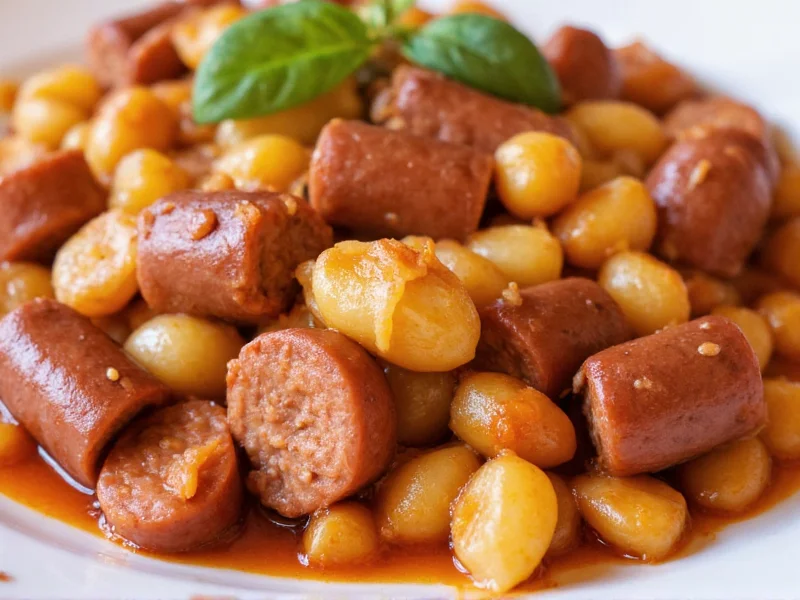When crafted properly, sausage and gnocchi dishes balance contrasting textures and complementary flavors that satisfy without overwhelming complexity. The key lies in understanding how these components interact during cooking and selecting quality ingredients that enhance rather than compete with each other.
Why Sausage and Gnocchi Make a Culinary Powerhouse
The magic of sausage and gnocchi together stems from their complementary characteristics. Italian sausage provides robust seasoning and meaty texture that stands up well to the delicate, cloud-like consistency of properly cooked gnocchi. Unlike pasta which requires precise timing to avoid overcooking, gnocchi's forgiving nature makes it ideal for one-pan sausage preparations where timing coordination matters.
Professional chefs favor this combination because both elements share similar cooking timelines. While the sausage browns and renders its flavorful fat, the gnocchi can simultaneously cook through without becoming waterlogged or mushy—a common pitfall with many quick-cooking pasta alternatives.
Selecting Your Foundation: Sausage and Gnocchi Varieties
Not all sausages and gnocchi perform equally in this dish. Understanding your options prevents disappointing results:
| Ingredient Type | Best Choices | Avoid |
|---|---|---|
| Sausage | Italian sweet or spicy (casings removed), chicken sausage with herbs | Pre-cooked sausages, heavily smoked varieties |
| Gnocchi | Fresh potato gnocchi, shelf-stable vacuum-sealed | Dried "gnocchi" (actually pasta), frozen with ice crystals |
| Sauce Base | Simple tomato, light cream, or garlic-olive oil | Heavy cheese sauces, overly complex reductions |
Mastering the Cooking Technique
Achieving perfect sausage and gnocchi requires attention to sequence and timing:
- Brown the sausage properly: Remove casings and break into small crumbles over medium-high heat. Allow proper browning without stirring constantly—this develops flavor through the Maillard reaction.
- Build your sauce foundation: After removing sausage, use the rendered fat to sauté aromatics like onions and garlic before adding tomatoes or cream.
- Cook gnocchi directly in the sauce: Unlike pasta, quality gnocchi shouldn't be boiled separately. Gently fold them into the simmering sauce for 2-3 minutes until they float and become tender.
- Finish with fresh elements: Off heat, incorporate fresh herbs, a splash of pasta water, and grated Parmesan for balanced flavor.
Avoiding Common Pitfalls
Even experienced home cooks encounter these issues with sausage and gnocchi dishes:
- Mushy gnocchi: Caused by overcooking or using frozen gnocchi without thawing. Solution: Add gnocchi to simmering (not boiling) liquid and cook just until they float.
- Greasy sauce: Results from not draining excess sausage fat. Solution: Remove sausage once browned, pour off all but 1-2 tablespoons of fat before continuing.
- Flavor imbalance: Overpowering sausage dominates delicate gnocchi. Solution: Use 8-10 oz sausage per 16 oz gnocchi with adequate sauce volume.
Variations for Every Dietary Preference
This versatile dish adapts beautifully to different needs:
For vegetarian sausage and gnocchi enthusiasts, substitute plant-based sausage crumbles and add mushrooms for umami depth. Those seeking healthy sausage and gnocchi options can use turkey sausage and incorporate spinach or kale during the final cooking minutes. Creamy sausage and gnocchi lovers achieve richness with a light cream sauce finished with lemon zest rather than heavy cheese additions.
Regional variations include adding white beans for protein, roasted red peppers for sweetness, or a splash of white wine for acidity. The best one-pan sausage gnocchi dinner recipes maintain simplicity while allowing for personalization.
Serving and Storage Considerations
Serve immediately for optimal texture, as gnocchi continues absorbing liquid when stored. Pair with a simple arugula salad and crusty bread to complete this quick weeknight dinner with gnocchi. Leftovers keep refrigerated for 2-3 days but require careful reheating:
- Stovetop: Gently warm in a covered skillet with a splash of broth or water
- Microwave: Heat in 30-second intervals with damp paper towel covering
- Avoid: Oven reheating (dries out gnocchi) or high-power microwaving
Freezing isn't recommended as gnocchi becomes waterlogged upon thawing, though the sauce component freezes well for future use.
Perfecting Your Sausage and Gnocchi Experience
The beauty of this dish lies in its adaptability to available ingredients and skill levels. Whether you're preparing an easy sausage and gnocchi recipe for your first attempt or refining your technique for special occasions, attention to ingredient quality and cooking sequence delivers consistently impressive results. By understanding why these components work together—complementary textures, shared cooking timelines, and flavor synergy—you'll create satisfying meals that feel more special than their simple preparation suggests.
Frequently Asked Questions
Can I use frozen gnocchi for sausage and gnocchi dishes?
Yes, but avoid boiling frozen gnocchi separately. Add them directly to your simmering sauce and cook 1-2 minutes longer than fresh varieties. Thawing first prevents excess water release that dilutes your sauce.
What's the best sausage for gnocchi that isn't too spicy?
Sweet Italian sausage provides ideal flavor without heat. For milder options, try chicken or turkey sausage with fennel and herbs. Avoid hot varieties unless you specifically want spiciness, as you can always add red pepper flakes later for controlled heat.
How do I prevent gnocchi from sticking together?
Gently fold gnocchi into simmering (not boiling) sauce rather than vigorous stirring. Use a wide skillet for even distribution and avoid overcrowding. Quality fresh or shelf-stable gnocchi rarely sticks when handled properly in adequate sauce.
Can I make sausage and gnocchi ahead of time?
Prepare components separately: brown sausage and make sauce up to 2 days ahead, store gnocchi separately. Combine and cook just before serving for best texture. Fully assembled dishes become mushy when reheated due to gnocchi's delicate structure.
What vegetables pair well with sausage and gnocchi?
Leafy greens like spinach or kale add nutrition without altering texture. Roasted bell peppers, caramelized onions, or sautéed mushrooms enhance flavor complexity. Add delicate vegetables during the last 2-3 minutes of cooking to maintain texture and color.











 浙公网安备
33010002000092号
浙公网安备
33010002000092号 浙B2-20120091-4
浙B2-20120091-4